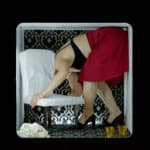Prima stanzaq (2008
by and with Marco Valerio Amico, Rhuena Bracci
sound Roberto Rettura
light design Fabio Sajiz
scenes in collaboration with Antonio Rinaldi
produced by Nanou Ass. Cult.
co-produced by Fondo Fare Anticorpi
with the support of Cantieri, Centrale Fies, L’Arboreto – Teatro Dimora di Mondaino, Città di Ebla, Teatro Fondamenta Nuove
First performance: Ferrara, Teatro Comunale, December 8, 2008
SECONDA STANZA (2010)
by Marco Valerio Amico, Rhuena Bracci
with Marco Valerio Amico, Rhuena Bracci, Marco Maretti
sound Roberto Rettura
light design Fabio Sajiz
scenes Antonio Rinaldi
produced by Nanou Ass. Cult.
co-produced by Fondazione Pontedera Teatro, Fondazione Fabbrica Europa, ZTL-Pro
in collaboration with Palladium – Università Roma Tre
with funding by Regione Emilia-Romagna Assessorato alla Cultura
with the support of Cantieri, Centrale Fies, L’Arboreto – Teatro Dimora di Mondaino, Ravenna Teatro, Città di Ebla
First performance: Firenze, Teatro Cantiere Florida, May 8, 2010 (Festival Fabbrica Europa).
Anticamera (2011)
by Marco Valerio Amico, Rhuena Bracci
with Marco Valerio Amico, Rhuena Bracci, Marco Maretti
sound Roberto Rettura
light design Fabio Sajiz
scenes Giovanni Marocco
produced by Nanou Ass. Cult.
co-produced by Armunia, Schloss Broellin
funded by MIBAC, Regione Emilia-Romagna Assessorato alla Cultura
with the support of Cantieri
First performance: Castiglioncello (LI), Tensostruttura, July 9, 2011 (Festival Inequilibrio).
Nanou group, Motel Project (2008-2011) – presentation
by Sergio Lo Gatto
The Motel project involves four years of work by the Ravenna group and performs a trilogy made up of three “rooms” (First Room, Second Room, Ante-room). The “rooms,” also presented separately, aren’t to be considered as three sequential episodes of a story, but rather as three “temporal units.” The “Motel” is treated conceptually as a non-place symbol. The project seemingly shifts a small group of characters from room to room, and their behavior and interaction are nevertheless not contingent on any actual identity or dramaturgy.
In the First Room the stale sentimental relationship between a man and a woman is portrayed as a monotonous round of the same never resolved issues. This glacial environment, which the light design emphasizes in an ascetic black and white, is generated by a table – fulcrum of the action – which is actually a box.
In the Second Room the floor is green, and we see reddish-purple armchairs and a couch, a table and furnishings in a setting that suggests the atmosphere of 1940’s detective films. There are frequent moments of darkness, while a careful light design frames sections of furniture and body details, without ever lighting up faces. Something violent seems to happen, some bloody mayhem the characters all seem to be in on.
Documents are published in original language. In case the translation is present, both the original and the translation are published.
First room
Trailer
edited by Giulia Fontanini
Second room
Trailer
edited by Giulia Fontanini
Anteroom
Trailer
edited by Giulia Fontanini
Motel. First study
Equilibrio Festival 2008 - Rome
Gianni Manzella, Edward Hopper danzato da nanou, «Il Manifesto», November 7, 2010
Giulia Tonucci, E, Artistic cooperation and special events, «Digicult», 2011
Roberta Ferraresi, Rivelazioni e nascondimenti nelle stanze di motel, «Il Tamburo di Kattrin», March 30, 2011
Simone Nebbia, Recensione, «Hystrio», April 2011
Sergio Lo Gatto, Motel. Tra sogno e corpo nella trilogia di gruppo nanou, «Teatro e Critica», July 13, 2011
Matteo Antonaci, Si chiudono le porte del Motel del gruppo nanou, «Artribune», August 26, 2011
Valentina Valentini, Fésta con E produzioni, «Alfabeta 2», June 12, 2012
Sergio Lo Gatto, Corpi senza volto al Motel, «Il Fatto Quotidiano», February 17, 2012
Valentina Valentini La querelle dei dispositivi, «Quaderni del Teatro di Roma», February 2013
Jennifer Malvezzi, Seduzioni Fotografiche. Una lettura delle stanze di gruppo nanou attraverso La Camera chiara di Roland Barthes, «Arabeschi» n. 6, September - December 2015








